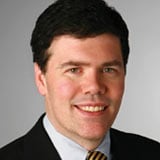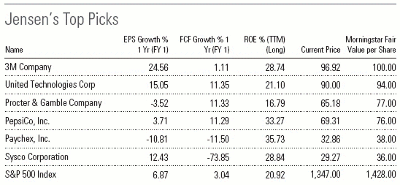The five-star Jensen Fund, which has some of the most rigorous selection criteria around, is finding value in globally oriented blue chips, write Russel Kinnel and Greg Carlson in Morningstar FundInvestor.
Jensen Fund’s (JENSX) managers aren’t exactly known for chasing trends. In fact, their investment process is one of the most disciplined, rigid ones around.
They consider purchasing only US-domiciled companies that have generated a return on equity of at least 15% in each of the past ten calendar years, a standard that whittles down the pool of candidates to fewer than 200 companies (and sometimes fewer than 150).
And for a firm to make it into the fund’s concentrated portfolio, it must typically clear the 15% hurdle by a comfortable margin on a consistent basis, and trade at a significant discount to its long-term prospects.
However, the managers’ stock-selection strategy isn’t set in stone. In the process of evaluating companies’ prospects (a rigorous exercise, as the typical holding period at the fund is more than seven years), the team often winds up taking into consideration not just industry dynamics, but the long-term macroeconomic picture.
In recent years, that has meant determining where economic growth and company profits are likely to come from in a rather sluggish environment. Along with many observers, the team expects emerging markets to significantly outperform the United States and Europe in that regard.
That doesn’t mean the managers are running out and buying emerging-markets stocks; they’re committed to keeping Jensen Fund focused on US firms. However, their views inform which stocks get included in the portfolio, and their position sizes.
Have Pedigree, Will Travel
At the top of the portfolio, for example, is 3M (MMM), with 5.1% of assets at the end of March.
The firm boasts a broadly diversified product line and sells those products to end markets across the globe. In 2009, 63% of the firm’s revenues came from sales outside the US, and a good chunk of those came from emerging markets (where margins are particularly high).
Co-manager Eric Schoenstein noted that 3M’s suite of safety and security products is in demand in Japan following the disasters there.
Schoenstein also cited industrial conglomerate United Technologies (UTX), also at 5.1% of assets, which has a similar, globally diversified profile.
The firm boasts a large order backlog, especially within its aerospace divisions (Pratt & Whitney and Sikorsky), and other long-established brands such as Otis elevators and Carrier air conditioners. It derives just more than 60% of its sales from outside the US, and boasts substantial emerging-market exposure.
Other examples of holdings with global reaches near the top of the fund’s portfolio include PepsiCo (PEP, 4.7% of assets) and Procter & Gamble (PG, 4.1% of assets).
One sign of how much faster emerging markets are growing: P&G recently reported in its second-quarter results that its sales volumes were growing by double-digit percentages in developing markets over the same quarter last year.
Meanwhile, growth was flat in North America and Europe. The recent surge of commodity prices directly affects the bottom lines of such staples suppliers. (This is especially true of PepsiCo, following the consolidation of its bottling operations 18 months ago.)
However, that also means the companies are trading somewhat cheaply. Furthermore, their dominant market shares should allow the firms to maintain their substantial profit margins by pushing through price increases.






















